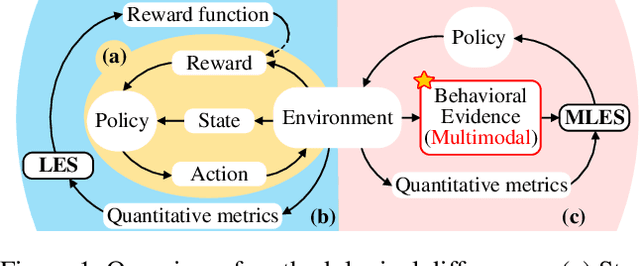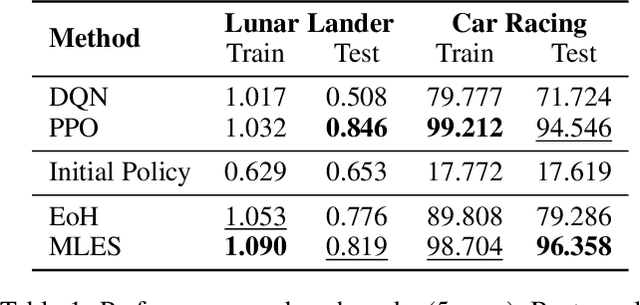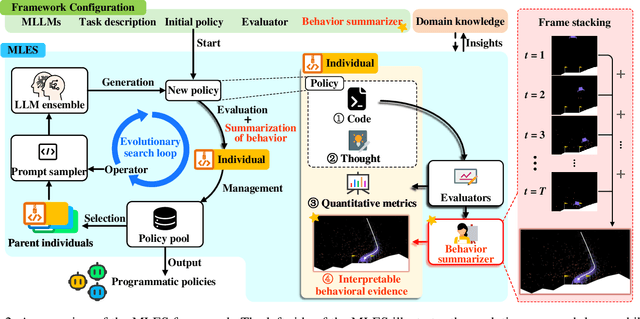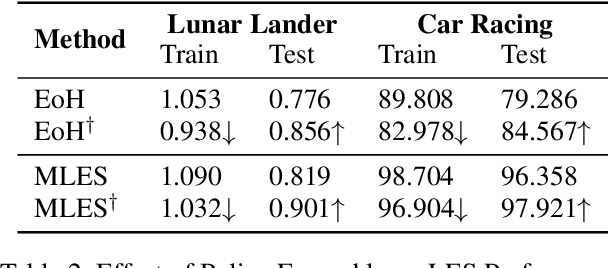Fei Liu
AstraNav-World: World Model for Foresight Control and Consistency
Dec 25, 2025Abstract:Embodied navigation in open, dynamic environments demands accurate foresight of how the world will evolve and how actions will unfold over time. We propose AstraNav-World, an end-to-end world model that jointly reasons about future visual states and action sequences within a unified probabilistic framework. Our framework integrates a diffusion-based video generator with a vision-language policy, enabling synchronized rollouts where predicted scenes and planned actions are updated simultaneously. Training optimizes two complementary objectives: generating action-conditioned multi-step visual predictions and deriving trajectories conditioned on those predicted visuals. This bidirectional constraint makes visual predictions executable and keeps decisions grounded in physically consistent, task-relevant futures, mitigating cumulative errors common in decoupled "envision-then-plan" pipelines. Experiments across diverse embodied navigation benchmarks show improved trajectory accuracy and higher success rates. Ablations confirm the necessity of tight vision-action coupling and unified training, with either branch removal degrading both prediction quality and policy reliability. In real-world testing, AstraNav-World demonstrated exceptional zero-shot capabilities, adapting to previously unseen scenarios without any real-world fine-tuning. These results suggest that AstraNav-World captures transferable spatial understanding and planning-relevant navigation dynamics, rather than merely overfitting to simulation-specific data distribution. Overall, by unifying foresight vision and control within a single generative model, we move closer to reliable, interpretable, and general-purpose embodied agents that operate robustly in open-ended real-world settings.
Selective Mixup for Debiasing Question Selection in Computerized Adaptive Testing
Nov 19, 2025Abstract:Computerized Adaptive Testing (CAT) is a widely used technology for evaluating learners' proficiency in online education platforms. By leveraging prior estimates of proficiency to select questions and updating the estimates iteratively based on responses, CAT enables personalized learner modeling and has attracted substantial attention. Despite this progress, most existing works focus primarily on improving diagnostic accuracy, while overlooking the selection bias inherent in the adaptive process. Selection Bias arises because the question selection is strongly influenced by the estimated proficiency, such as assigning easier questions to learners with lower proficiency and harder ones to learners with higher proficiency. Since the selection depends on prior estimation, this bias propagates into the diagnosis model, which is further amplified during iterative updates, leading to misalignment and biased predictions. Moreover, the imbalanced nature of learners' historical interactions often exacerbates the bias in diagnosis models. To address this issue, we propose a debiasing framework consisting of two key modules: Cross-Attribute Examinee Retrieval and Selective Mixup-based Regularization. First, we retrieve balanced examinees with relatively even distributions of correct and incorrect responses and use them as neutral references for biased examinees. Then, mixup is applied between each biased examinee and its matched balanced counterpart under label consistency. This augmentation enriches the diversity of bias-conflicting samples and smooths selection boundaries. Finally, extensive experiments on two benchmark datasets with multiple advanced diagnosis models demonstrate that our method substantially improves both the generalization ability and fairness of question selection in CAT.
Debate over Mixed-knowledge: A Robust Multi-Agent Framework for Incomplete Knowledge Graph Question Answering
Nov 15, 2025Abstract:Knowledge Graph Question Answering (KGQA) aims to improve factual accuracy by leveraging structured knowledge. However, real-world Knowledge Graphs (KGs) are often incomplete, leading to the problem of Incomplete KGQA (IKGQA). A common solution is to incorporate external data to fill knowledge gaps, but existing methods lack the capacity to adaptively and contextually fuse multiple sources, failing to fully exploit their complementary strengths. To this end, we propose Debate over Mixed-knowledge (DoM), a novel framework that enables dynamic integration of structured and unstructured knowledge for IKGQA. Built upon the Multi-Agent Debate paradigm, DoM assigns specialized agents to perform inference over knowledge graphs and external texts separately, and coordinates their outputs through iterative interaction. It decomposes the input question into sub-questions, retrieves evidence via dual agents (KG and Retrieval-Augmented Generation, RAG), and employs a judge agent to evaluate and aggregate intermediate answers. This collaboration exploits knowledge complementarity and enhances robustness to KG incompleteness. In addition, existing IKGQA datasets simulate incompleteness by randomly removing triples, failing to capture the irregular and unpredictable nature of real-world knowledge incompleteness. To address this, we introduce a new dataset, Incomplete Knowledge Graph WebQuestions, constructed by leveraging real-world knowledge updates. These updates reflect knowledge beyond the static scope of KGs, yielding a more realistic and challenging benchmark. Through extensive experiments, we show that DoM consistently outperforms state-of-the-art baselines.
Discovering Interpretable Programmatic Policies via Multimodal LLM-assisted Evolutionary Search
Aug 07, 2025



Abstract:Interpretability and high performance are essential goals in designing control policies, particularly for safety-critical tasks. Deep reinforcement learning has greatly enhanced performance, yet its inherent lack of interpretability often undermines trust and hinders real-world deployment. This work addresses these dual challenges by introducing a novel approach for programmatic policy discovery, called Multimodal Large Language Model-assisted Evolutionary Search (MLES). MLES utilizes multimodal large language models as policy generators, combining them with evolutionary mechanisms for automatic policy optimization. It integrates visual feedback-driven behavior analysis within the policy generation process to identify failure patterns and facilitate targeted improvements, enhancing the efficiency of policy discovery and producing adaptable, human-aligned policies. Experimental results show that MLES achieves policy discovery capabilities and efficiency comparable to Proximal Policy Optimization (PPO) across two control tasks, while offering transparent control logic and traceable design processes. This paradigm overcomes the limitations of predefined domain-specific languages, facilitates knowledge transfer and reuse, and is scalable across various control tasks. MLES shows promise as a leading approach for the next generation of interpretable control policy discovery.
Knowledge-aware Diffusion-Enhanced Multimedia Recommendation
Jul 22, 2025



Abstract:Multimedia recommendations aim to use rich multimedia content to enhance historical user-item interaction information, which can not only indicate the content relatedness among items but also reveal finer-grained preferences of users. In this paper, we propose a Knowledge-aware Diffusion-Enhanced architecture using contrastive learning paradigms (KDiffE) for multimedia recommendations. Specifically, we first utilize original user-item graphs to build an attention-aware matrix into graph neural networks, which can learn the importance between users and items for main view construction. The attention-aware matrix is constructed by adopting a random walk with a restart strategy, which can preserve the importance between users and items to generate aggregation of attention-aware node features. Then, we propose a guided diffusion model to generate strongly task-relevant knowledge graphs with less noise for constructing a knowledge-aware contrastive view, which utilizes user embeddings with an edge connected to an item to guide the generation of strongly task-relevant knowledge graphs for enhancing the item's semantic information. We perform comprehensive experiments on three multimedia datasets that reveal the effectiveness of our KDiffE and its components on various state-of-the-art methods. Our source codes are available https://github.com/1453216158/KDiffE.
Improving Noise Robustness of LLM-based Zero-shot TTS via Discrete Acoustic Token Denoising
May 22, 2025Abstract:Large language model (LLM) based zero-shot text-to-speech (TTS) methods tend to preserve the acoustic environment of the audio prompt, leading to degradation in synthesized speech quality when the audio prompt contains noise. In this paper, we propose a novel neural codec-based speech denoiser and integrate it with the advanced LLM-based TTS model, LauraTTS, to achieve noise-robust zero-shot TTS. The proposed codec denoiser consists of an audio codec, a token denoiser, and an embedding refiner. The token denoiser predicts the first two groups of clean acoustic tokens from the noisy ones, which can serve as the acoustic prompt for LauraTTS to synthesize high-quality personalized speech or be converted to clean speech waveforms through the embedding refiner and codec decoder. Experimental results show that our proposed codec denoiser outperforms state-of-the-art speech enhancement (SE) methods, and the proposed noise-robust LauraTTS surpasses the approach using additional SE models.
Cost-Augmented Monte Carlo Tree Search for LLM-Assisted Planning
May 20, 2025Abstract:While LLMs excel at open-ended reasoning, they often struggle with cost-sensitive planning, either treating all actions as having equal cost or failing to stay within strict budgets. In this paper, we introduce Cost-Augmented Monte Carlo Tree Search (CATS), a novel approach that brings explicit cost-awareness into LLM-guided planning. Tight cost constraints push the planner to quickly identify infeasible solutions, while looser constraints encourage optimization for minimal cost. We benchmark top LLMs such as GPT-4.1, Claude-3.7-Sonnet, and DeepSeek-R1, against our CATS planner to evaluate their performance in cost-sensitive scenarios. Our experiments suggest that raw LLMs such as GPT-4.1 often falter under tight budgets, whereas CATS consistently delivers strong performance, achieving higher task success rates and better cost efficiency. CATS provides an effective solution for budget-aware decision-making by combining the reasoning power of LLMs with structured search.
OmniStyle: Filtering High Quality Style Transfer Data at Scale
May 20, 2025



Abstract:In this paper, we introduce OmniStyle-1M, a large-scale paired style transfer dataset comprising over one million content-style-stylized image triplets across 1,000 diverse style categories, each enhanced with textual descriptions and instruction prompts. We show that OmniStyle-1M can not only enable efficient and scalable of style transfer models through supervised training but also facilitate precise control over target stylization. Especially, to ensure the quality of the dataset, we introduce OmniFilter, a comprehensive style transfer quality assessment framework, which filters high-quality triplets based on content preservation, style consistency, and aesthetic appeal. Building upon this foundation, we propose OmniStyle, a framework based on the Diffusion Transformer (DiT) architecture designed for high-quality and efficient style transfer. This framework supports both instruction-guided and image-guided style transfer, generating high resolution outputs with exceptional detail. Extensive qualitative and quantitative evaluations demonstrate OmniStyle's superior performance compared to existing approaches, highlighting its efficiency and versatility. OmniStyle-1M and its accompanying methodologies provide a significant contribution to advancing high-quality style transfer, offering a valuable resource for the research community.
Learning to Insert for Constructive Neural Vehicle Routing Solver
May 20, 2025



Abstract:Neural Combinatorial Optimisation (NCO) is a promising learning-based approach for solving Vehicle Routing Problems (VRPs) without extensive manual design. While existing constructive NCO methods typically follow an appending-based paradigm that sequentially adds unvisited nodes to partial solutions, this rigid approach often leads to suboptimal results. To overcome this limitation, we explore the idea of insertion-based paradigm and propose Learning to Construct with Insertion-based Paradigm (L2C-Insert), a novel learning-based method for constructive NCO. Unlike traditional approaches, L2C-Insert builds solutions by strategically inserting unvisited nodes at any valid position in the current partial solution, which can significantly enhance the flexibility and solution quality. The proposed framework introduces three key components: a novel model architecture for precise insertion position prediction, an efficient training scheme for model optimization, and an advanced inference technique that fully exploits the insertion paradigm's flexibility. Extensive experiments on both synthetic and real-world instances of the Travelling Salesman Problem (TSP) and Capacitated Vehicle Routing Problem (CVRP) demonstrate that L2C-Insert consistently achieves superior performance across various problem sizes.
REMEDI: Relative Feature Enhanced Meta-Learning with Distillation for Imbalanced Prediction
May 12, 2025Abstract:Predicting future vehicle purchases among existing owners presents a critical challenge due to extreme class imbalance (<0.5% positive rate) and complex behavioral patterns. We propose REMEDI (Relative feature Enhanced Meta-learning with Distillation for Imbalanced prediction), a novel multi-stage framework addressing these challenges. REMEDI first trains diverse base models to capture complementary aspects of user behavior. Second, inspired by comparative op-timization techniques, we introduce relative performance meta-features (deviation from ensemble mean, rank among peers) for effective model fusion through a hybrid-expert architecture. Third, we distill the ensemble's knowledge into a single efficient model via supervised fine-tuning with MSE loss, enabling practical deployment. Evaluated on approximately 800,000 vehicle owners, REMEDI significantly outperforms baseline approaches, achieving the business target of identifying ~50% of actual buyers within the top 60,000 recommendations at ~10% precision. The distilled model preserves the ensemble's predictive power while maintaining deployment efficiency, demonstrating REMEDI's effectiveness for imbalanced prediction in industry settings.
 Add to Chrome
Add to Chrome Add to Firefox
Add to Firefox Add to Edge
Add to Edge